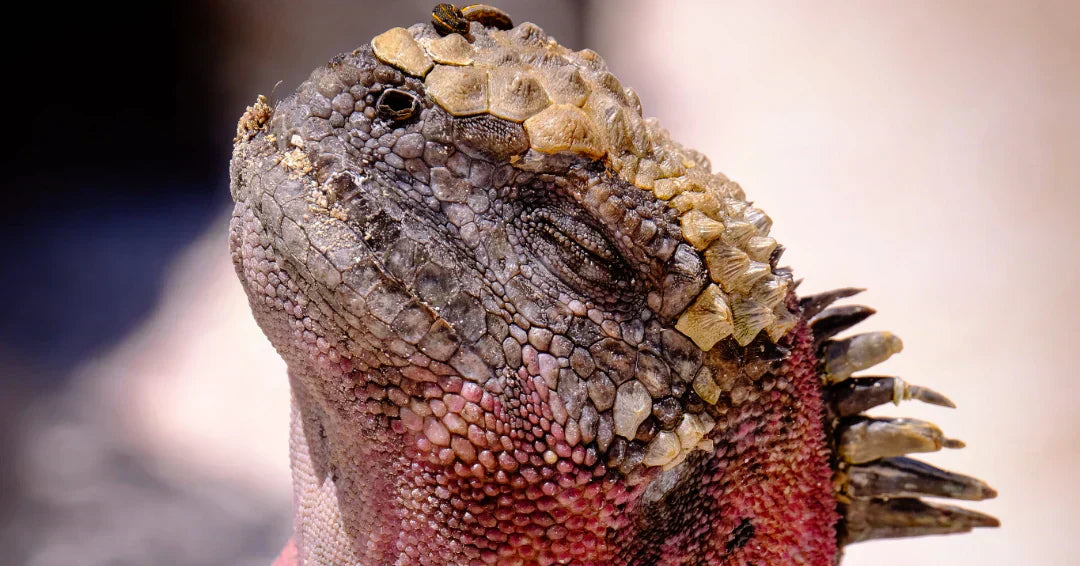Large lizards like iguanas are interesting creatures that thrive in their natural habitat. Lots of kids take an interest in adopting them as pets. Unlike goldfish, hamsters, and other small housemates, iguanas are much more complicated creatures. Before taking the step toward purchasing a new lizard friend, consider learning everything possible about the behaviors, environment, reproduction, and socialization. Remember, these animals are not meant to be domesticated, so there are very specific conditions that must be met in order for them to live long and healthy lives. Here are some of the most interesting facts about iguanas to consider.

What To Know Before Adopting an Iguana
Taking on a reptilian pet may seem like a fairly easy task, especially when comparing the care associated with animals that roam free around the house. While they are fascinating to observe, they come with a much higher cost and responsibility than other caged pets. Unfortunately, many owners learn too late that the responsibilities are greater and more costly than expected. It is important to do a lot of research before bringing a small reptile into the home. These popular pets can live for a very long time when cared for properly at home. They are better suited for older children who are responsible enough to handle them properly and take care of their needs. Be sure to read children books about iguanas for information about the environment, food, and other conditions necessary to provide a healthy lifestyle. Kids who are fascinated with these long-bodied lizards will want to know the most important aspects about owning iguana before adopting one as a pet.
Fun Facts About Iguanas Just for Kids
Kids are naturally curious, and iguanas tap into that desire to learn in several ways. Their dinosaur-like appearance, with scaly skin and spiny backs, immediately captures a child's imagination. This resemblance to prehistoric creatures, a perennial favorite among kids, makes them fascinating and exciting to learn about. Iguanas also introduce children to a world of diverse colors and habitats. From the vibrant green iguanas of the rainforest to the unique marine iguanas of the Galápagos Islands, these reptiles offer a glimpse into different ecosystems and the concept of adaptation. Finally, iguanas possess amazing and unexpected abilities that kids find captivating. For example, some species can drop and regrow their tails, while others can hold their breath underwater for an extended period. These unique skills make learning about iguanas even more engaging and memorable for young minds. Continue reading to discover the most fascinating iguana facts.

Behavior of Iguanas
Iguana behavior is fun to learn about because their actions are expressive, diverse, and often surprising. Their silent communication and clever survival strategies are both fascinating and entertaining to observe.

(1) Iguanas know their owners.
Although these lizards do not offer the same level of companionship and recognition as other types of pets, they absolutely do respond to their caretakers. Iguanas have keen vision and an uncanny ability to recognize sounds. While they will not respond to someone calling to them, iguanas can distinguish between different voices.
(2) These creatures do not like to be touched.
Unlike other pets that welcome the human touch, iguanas feel intense levels of stress when handled. Do not be misled into thinking that it can learn to enjoy a nice pat on the back. Petting may result in a good whip by the tail.
(3) Iguanas are diurnal creatures that rise with the sun.
Most reptiles are nocturnal, but iguanas keep the same schedule as human owners. This is a benefit for kids who will enjoy observing them scamper and play during daytime hours.
(4) Look for warning signs to avoid getting bitten.
While normally non-aggressive by nature, keep in mind that these big lizards have very strong jaws and sharp teeth capable of delivering painful bites. The razor sharp incisors, designed to rip apart plants and vegetation for consumption, can easily break the skin of humans or other pets in the home. The good news is that the warning signs before an attack are obvious. They stand on their hind legs, lean forward toward the victim, and bob their heads back and forth in an effort to appear larger and more threatening.
(5) Iguanas can hold their breath underwater for up to to 30 minutes.
There are many reasons why an iguana may decide to go for a swim. They may simply feel like splashing around or floating on a peaceful lake. Often jump in to find food, particularly various types of algae that grow on rocks beneath the water's surface. Their bodies look like snakes as they wiggle across the bottom of the body of water, using their long claws to scrape for food. Iguanas also dive deep underwater to escape predators like birds, raccoons, and other land animals. Although they cannot breath like fish, these critters can hold their breath for 30 minutes at a time. Interestingly, green iguanas can stay submerged for four long hours when the conditions are just right. The water needs to be cold enough not to damage their cold-blooded system and warm enough to slow down their breathing.
Iguana Anatomy
Iguana anatomy is interesting because their bodies have evolved unique features that are perfectly adapted for survival. Learning about these anatomical adaptations offers a fascinating look into how an animal's physical structure is perfectly suited for its environment and lifestyle.

(6) Sometimes they lose their tails.
This is a survival tactic when snagged by predators in the wild. The muscles between the vertebrae allow for a clean break of the tail, which often grows back if the iguana is healthy. Pets make snap off their tail if it somehow gets caught on something or prevents them from moving freely. It may be worth having a veterinarian examine the pet to make sure medical intervention is not required.
(7) These lizards frequently shed their skin.
Multiple times every year, iguanas will go through a process of eliminating their outer skin layer. When this occurs, the skin will turn dull and iguanas will often rub up against nearby objects to help scrape it off. If you notice a pet iguana sitting still with its eyes squeezed shut, take note of its body. It will likely look a bit puffier as this also helps it shed its skin.
(8) Iguanas have three eyes.
A pretty interesting fact about iguanas that most people may not know is the presence of a third eye on the top of their heads. This eye looks more like a grey spot than a typical eyeball, and it is not designed for vision. Rather, it is referred to as a parietal eye, one that senses light and movement from above. This eye is part of an iguanas defense system as it allows them to detect predators like hawks and owls.The two eyes on the face function like most others. They only have a few cell rods, though, so in low light conditions their vision is compromised. However, during the middle of the day when the sun is shining, iguanas can see long distances.

Iguana Habitat and Diet
(9) Iguanas require high temperatures to survive.
These reptiles are ectotherms, meaning that their body temperature is dependent on the surrounding environment. The ideal range is mid-70s to 90 degrees Fahrenheit. Pet owners will want to be sure the glass enclosures are fitted with ceramic or mercury bulbs to provide sufficient heat. When the temperature is too low, immune systems will fail and metabolism will slow to dangerous levels.
(10) Iguanas are herbivores.
Animal proteins are extremely harmful for an iguana's kidneys, so meat should not be incorporated into the diet. To keep a pet healthy, dark leafy greens are recommended. Iguanas also can benefit from other vegetables like snap peas, peppers, carrots, and squash.

Lifespan of Iguanas
The lifespan of an iguana is surprisingly varied and interesting, largely because it's not a single number. Instead, it changes dramatically based on the species and whether the iguana lives in the wild or in captivity. This wide range reveals a lot about their survival strategies and the challenges they face.

(11) Iguanas live from 8 to 20 years depending on their habitat.
Like any other living being, there are many different factors that affect the lifespan of iguanas. When iguanas live in captivity, for example a zoo or a home, their life expectancy greatly depends on the quality of care. Although rare, some have reportedly lived to the ripe old age of 20. However, most succumb to kidney disease or other ailments around 9 years of age. Some of the most common reasons for their early demise are improper nutrition, inadequate climate control, and insufficient living space.
(12) Predators are the biggest threat to iguanas living in the wild.
The general consensus is that iguanas typically survive an average of 8 years living in their natural habitat. Predators post the biggest threat to hatchlings, babies, and sometimes full grown iguanas. Raccoons, hawks, owls, and even cats and dogs are just a few of the many animals that kill small iguanas. Larger ones are often eaten by alligators, jaguars, boa constrictors, pumas, and other large predatory animals.

Tips for Owning a Pet Iguana
The popular image of a small, docile iguana in a pet store is misleading. The reality of caring for an adult iguana is vastly different, which is why it's so important to learn about them. These animals are often misunderstood and demand a specific, long-term commitment that many prospective owners aren't prepared to give.

(13) Reptiles are expensive pets to both acquire and maintain.
In addition to the cost of the lizard, the large glass enclosure it requires is not cheap. Furthermore, they need to live in a temperature controlled environment with costly bulbs to provide heat and light. And then there is the heft price tag of seeking care from exotic veterinarians since the normal doctors don't usually treat reptiles.
(14) Iguanas require a lot of space in the house.
Full-sized iguanas can grow to almost 72 inches, or six feet long, and reach up to 20 pounds. The terrarium needs to be large enough for this huge lizard to move and play comfortably. If not, the pet iguana's health and wellbeing will be jeopardized.
(15)Adopting an iguana is a long-term commitment.
These hearty reptiles can live to be twenty years old when cared for properly. With the proper diet and environment, iguanas in captivity can thrive for two whole decades.
(16) Look no further than your refrigerator or backyard to feed a pet iguana.
There is no need to shop for gourmet feed, live crickets, or other gross specimens to feed a pet iguana. They are herbivores, so any leafy greens or vegetables will do just fine. You can even pick flowers from outside to feed these plant-loving animals.







